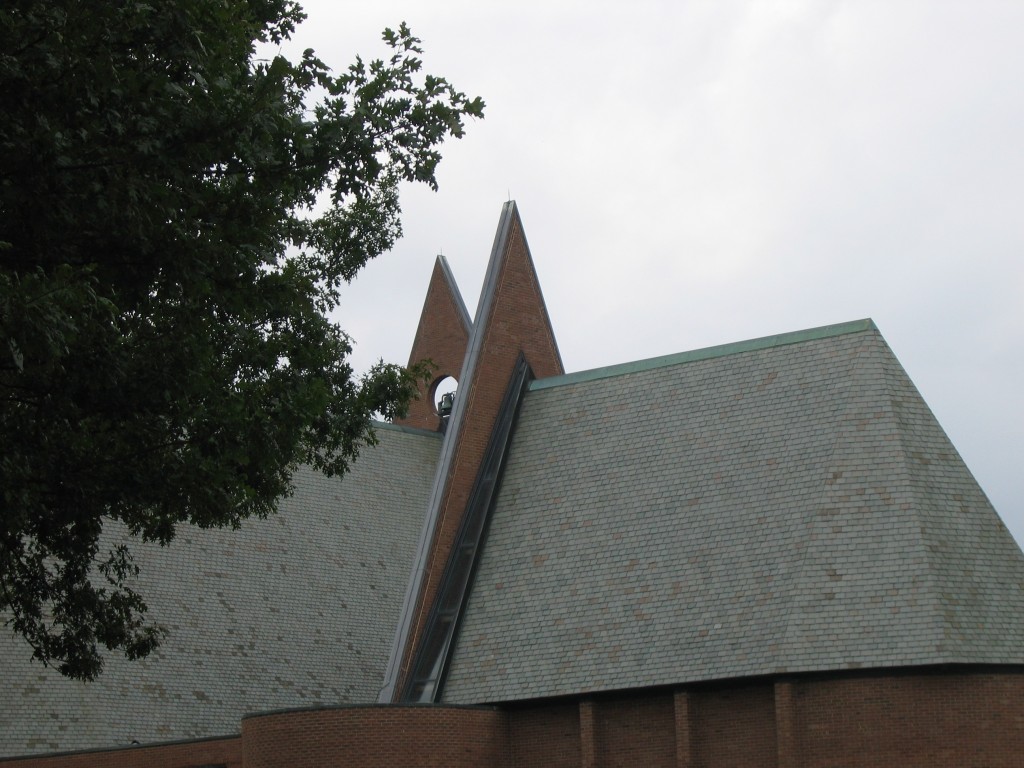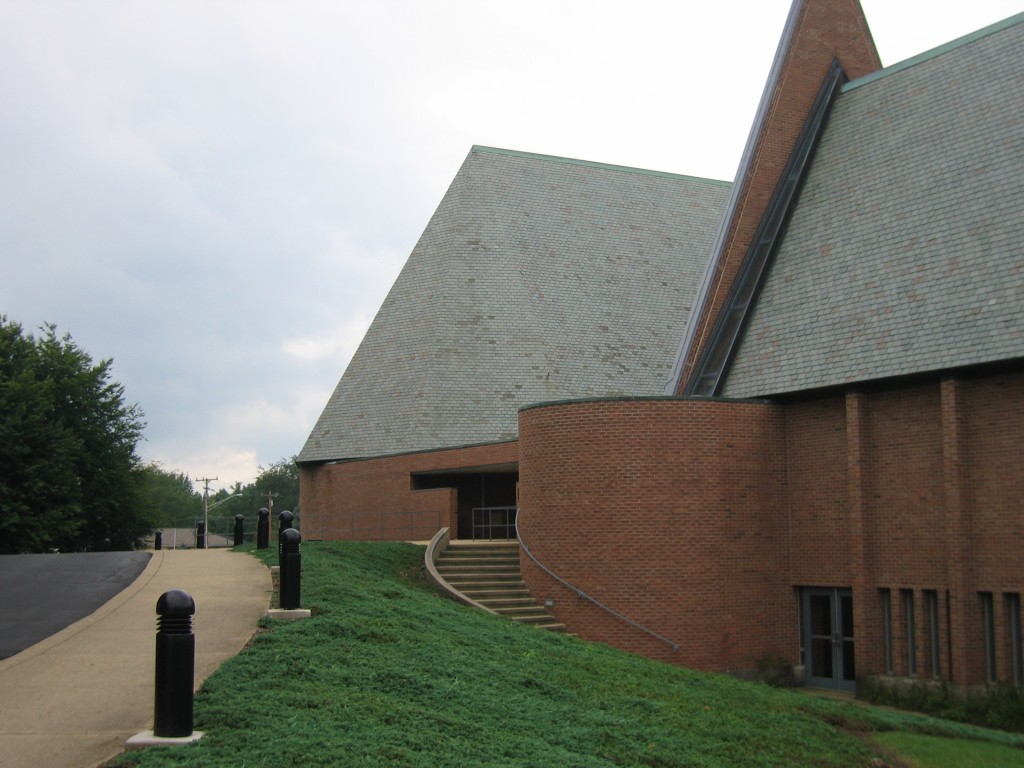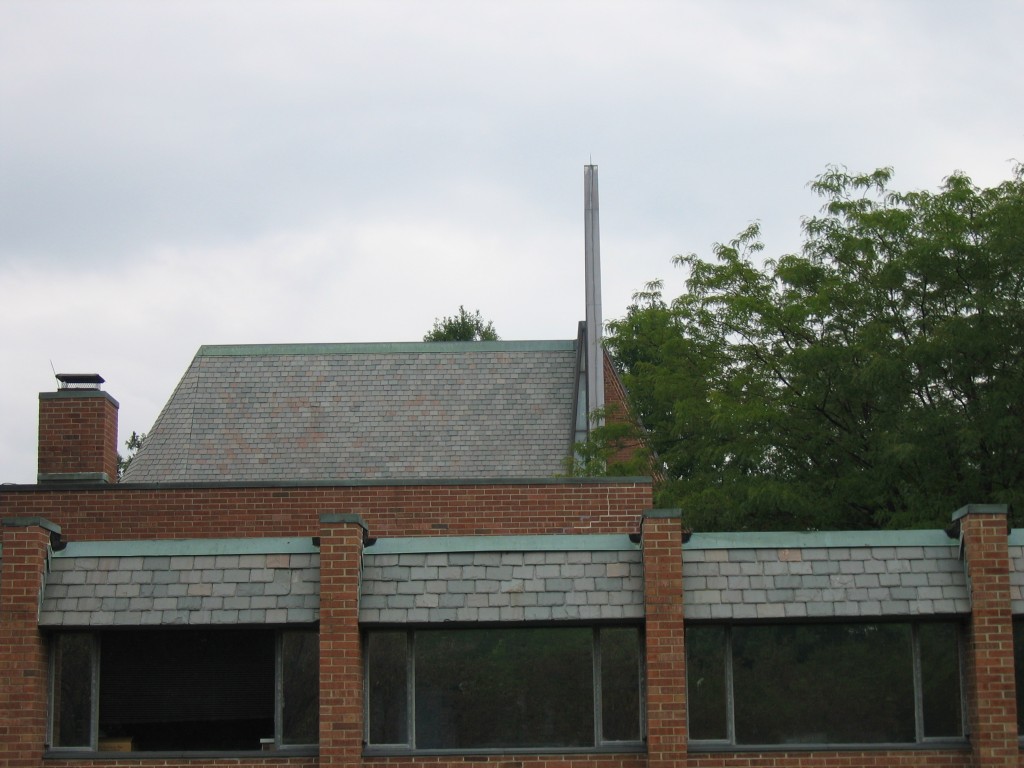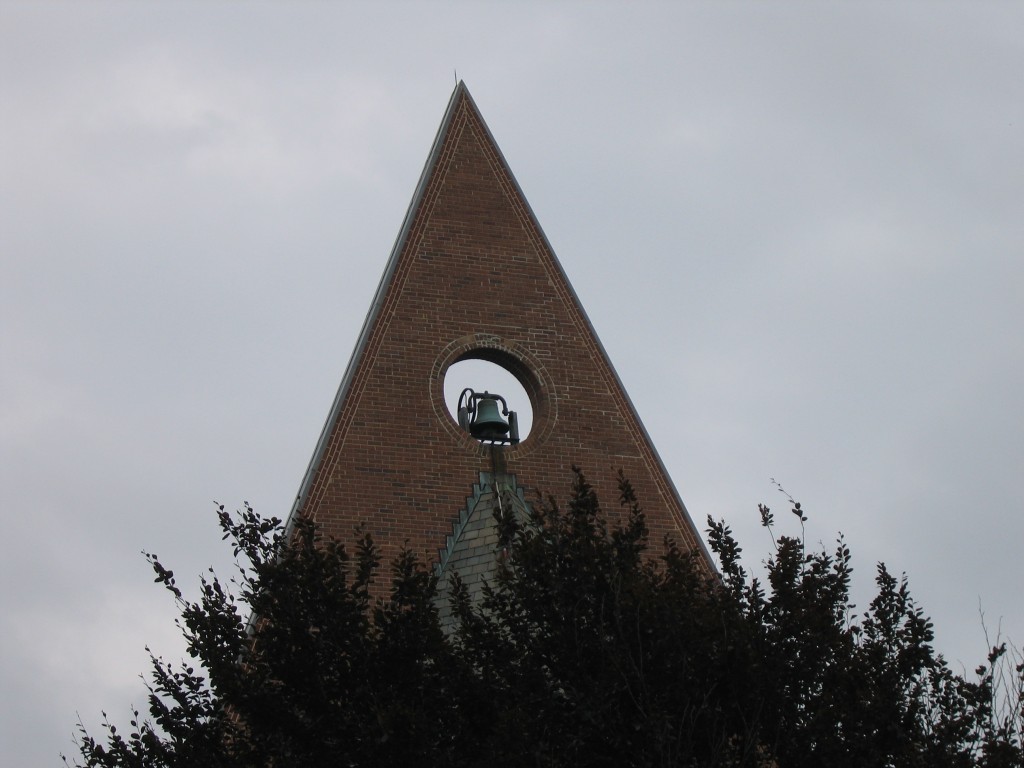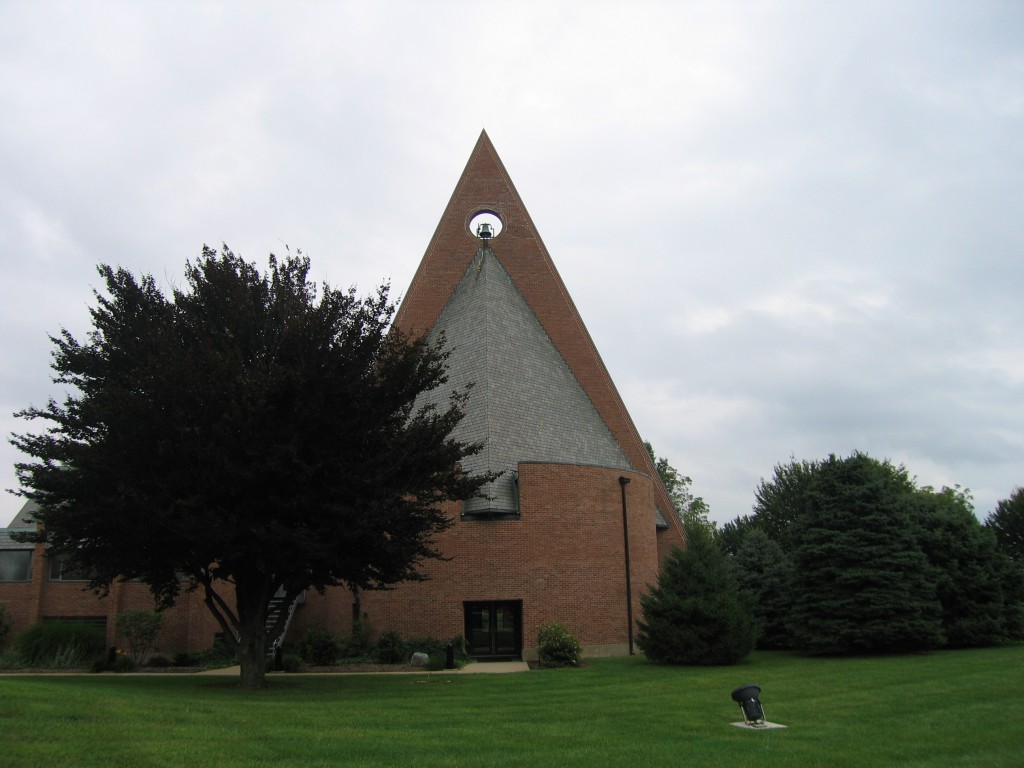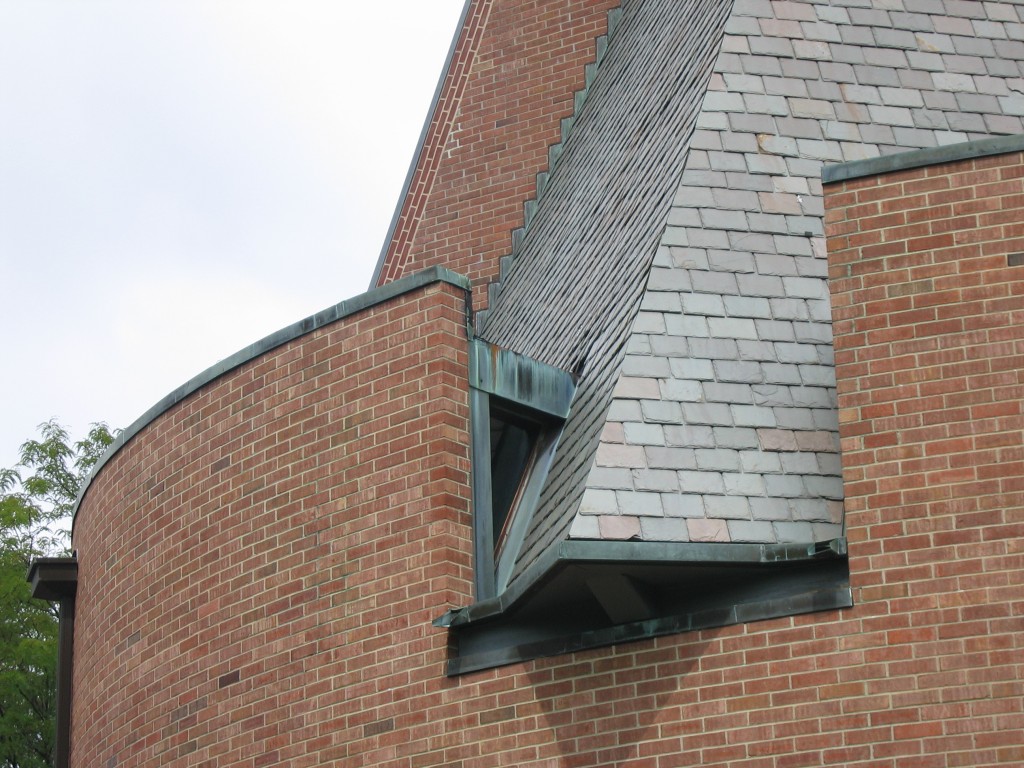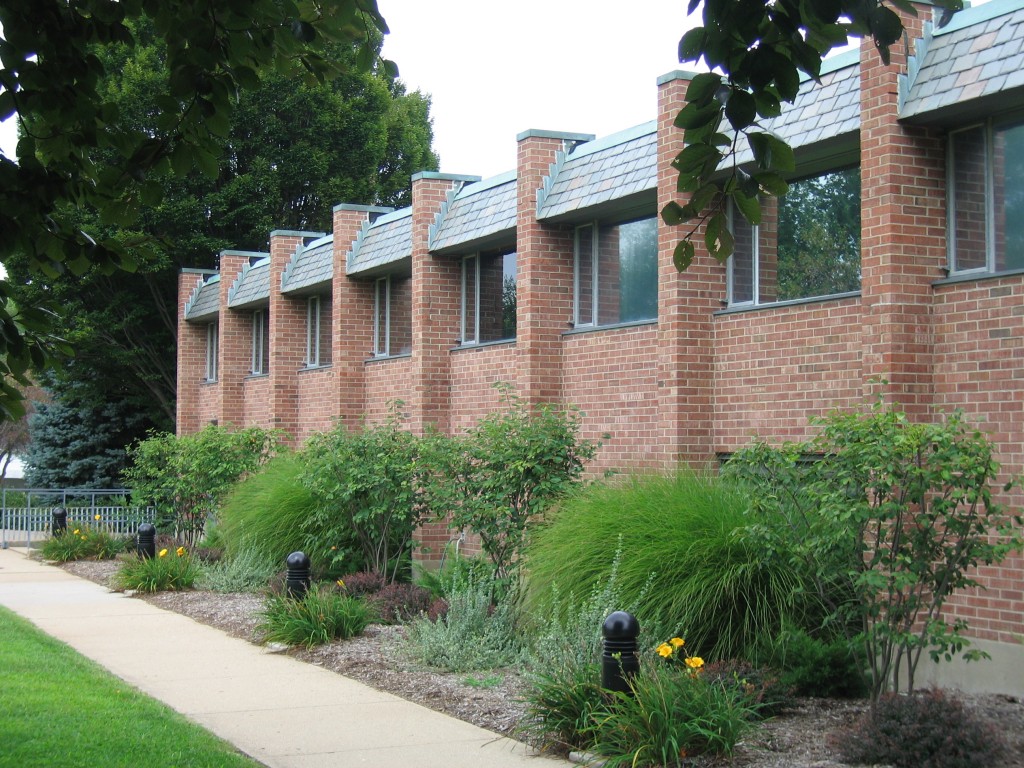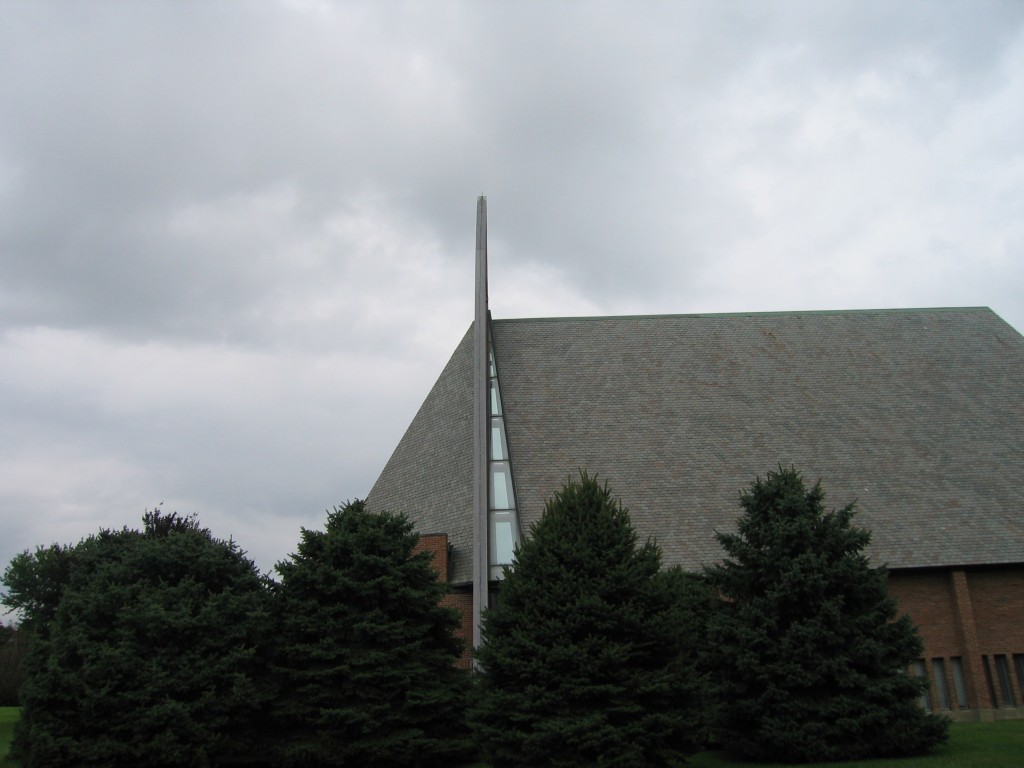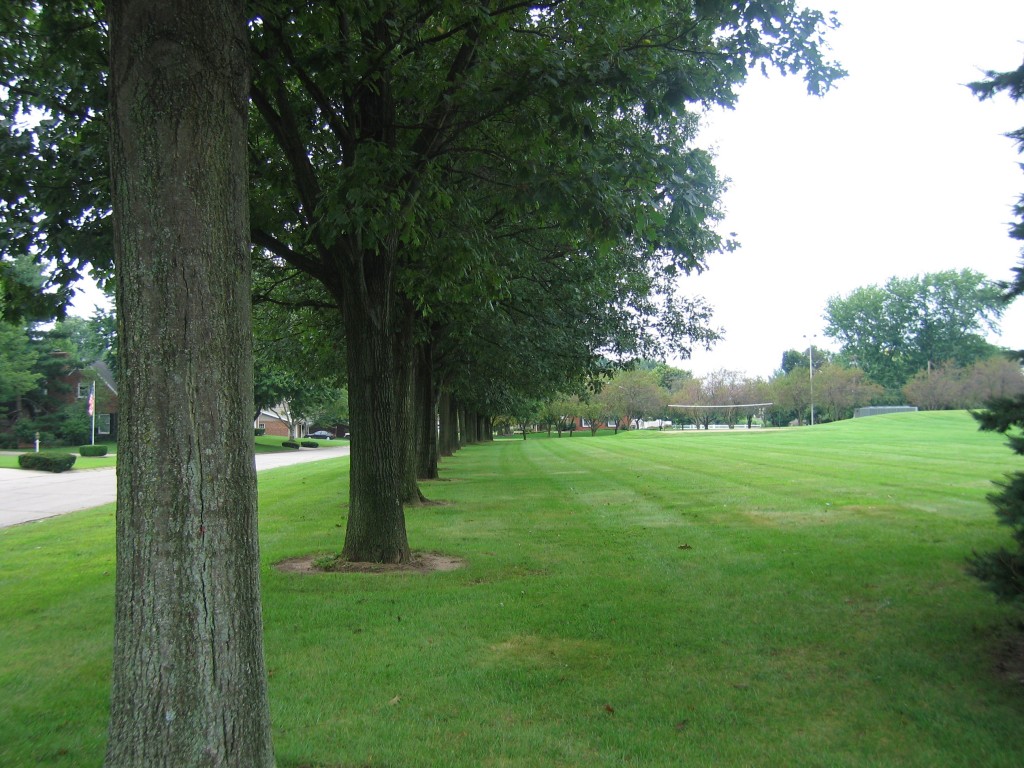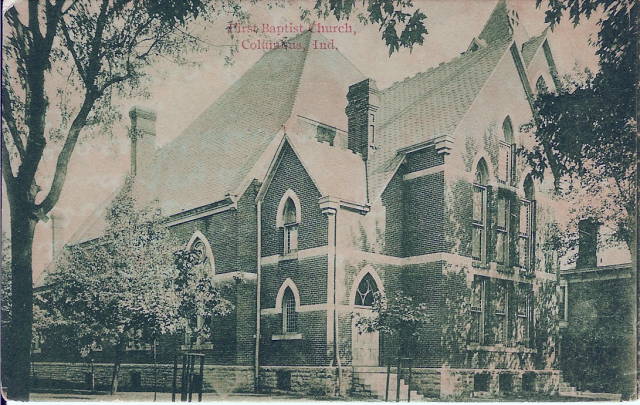v12.08.14
Art, Architecture and Design
This article spotlights a particular building or some other aspect of Columbus design. I welcome your comments, corrections and additions. Please share your experience and perceptions of these uniquely Columbus projects.
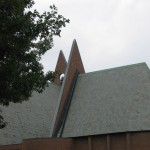 First Baptist Church
First Baptist Church
- Built: 1965
- Architect: Harry Weese, Chicago
- Landscaping: Dan Kiley
- Design Team:
- Jack Hartray: Project manager
- Houng-Lin Swei: Project designer
- Repp & Mundt: Contractor
- Honors: National Historic Landmark – 2000
As an active congregation, First Baptist dates back to 1852 when the congregation was organized. For many years they met at 625 Franklin Street, a block north from the Visitors Center (site is now part of the parking lot). As they began to outgrow their building they started exploring new church designs, architects and locations while raising funds to complete the project. A site was purchased at 20th and Midway in 1956 and Harry Weese was later chosen for the project. The preliminary Weese designs were done with that original very level location in mind.
They needed a much larger church building and desired a lot of classroom space for Sunday School and other educational purposes. Rather than design the typical sanctuary with a sprawling auxiliary wing, Weese chose a smaller footprint on two levels. When the location was changed, the design was adapted to the hilly new 7 acre site giving it an even more majestic position due to the multi-levels on top of the hill. Construction began in the Spring of 1964.
This National Historic Landmark church was built on the brow of a gently sloping knoll, on one of the very highest points on the mostly flat landscape of Columbus. It has often been described as a modern abstraction of a Gothic European cathedral, executing traditional liturgical forms in very modernistic ways. The very steep slate roof is twice as high as the supporting brick walls encasing the high A-frame sanctuary. Quicksand was discovered as construction started requiring pylons drilled very deep into the ground to support the foundation.
It is a two-story 28,000 square foot building on two floors around a central courtyard utilizing the natural topography so that the main entrance occurs at the second level with the sanctuary and chapel adjacent. Weese laid out the design to fit well into the future plans for Richards Elementary to the East and to the future city golf course to the north. Construction consisted of brick bearing walls, concrete floors and a heavy timber roof covered in green Vermont slate. Weese originally intended the walls to be of cast concrete but was convinced by the congregation to switch to brick. Brick walls are prominent inside and out. Brick was made by the Devening Block company in nearby Garden city. A specially made curved brick was used to allow very smooth curved surfaces that are found throughout the building. The building was originally naturally ventilated but duct work was put in place for a future addition of air conditioning. The congregation chose to delay the air conditioning rather than cut out other parts of the design more critical to the architecture.
The lower level contains 25 classrooms, 4 restrooms and the heating plant. A kind of “moat” surrounds the lower level allowing room for small windows bringing natural light into the rooms. If you look at the main entrance from the side it resembles a lowered drawbridge onto the second level. The main entrance is a distinctive low and wide T-shaped opening.
The upper level consists of the sanctuary (seating 500) and a chapel (seating 100). The sanctuary is elevated a few feet higher than the main part of the upper level. The chapel is a miniature version of the sanctuary set at a perpendicular angle. The upper level also contains an Fellowship Hall that can seat 300 people at tables or can also be split up into 3 separate sections. This level also contains a kitchen, two choir rooms and administrative offices.
The front entryway and ceilings in adjacent hallways were kept very low to symbolize the lowliness of humankind. As you climb the several feet to reach the high-pitched sanctuary it causes a natural upward gaze meant to lift all thoughts to the higher power. Entering into the sanctuary from the confined entry way causes an “explosion of space” intended to make one feel awed by the sudden openness. The primary visible light is above reminding the congregation of the one who is the light of the world.
The high A-framed sanctuary space with vaulted wood ceilings is windowless on the sides to shut out distractions. Hidden windows under the eaves provide indirect natural light as well as ventilation. The ceilings are 49 feet high at the peak and constructed of exposed tongue and groove decking supported by laminated wood beams. Some think the ceiling resembles the inverted keel of a great ship. The wood used in the ceiling decking was deliberately chosen to have more knotholes in the rear and gets progressively smoother as you get closer to the altar area (meant to symbolize the increasing level of perfection that can be achieved as you get closer to God).
One of the prominent interior features is the wall of pierced brick at the front of the sanctuary formed by the flat non-dimensional triangular wall which also serves as the bell tower. This pierced brick wall is reminiscent of a rood screen, a fixture in early European churches. These vertically-oriented rectilinear openings in the wall partially shield the choir and organist from the congregation. It is meant to be a reminder of the rending of the veil of the temple following the crucifixion of Jesus Christ, signifying that henceforth all have access to God. If you look very high you can see the organ pipes through the openings behind the cross. It also had a strictly utilitarian purpose as it contained ductwork for the then unfinished air conditioning system within the hollow brick columns.
All sanctuary elements such as the communion table, the center aisle between the white oak pews and the pulpit are off-center except the wooden cross which seems to float in mid-air above the pulpit area. It was centered to act as the main point of focus reminding the congregation of the centrality of the crucification to Christianity. It has been said that the fabrication of the cross had somehow been neglected during the construction phase and was hastily made with wood from the scrap pile in the very last hours before the church was to open. The rugged wooden cross was so effective that it was left in place. The full-immersion Baptistery is on the far right with its entry from behind the pierced wall. The altar area is filled with natural light coming from the narrow strip of vertical windows rising the height of the roof along the bell tower wall. The sanctuary was set to maximize the effect of the morning sun. As the sun passes it slowly and dramatically floods across the alter wall, then retreats back.
The Courtyard is directly accessible from both levels and provides an outdoor gathering area for fellowship and refreshment. The cornerstone from the 1852 church is on a pedestal in the courtyard. Other artifacts from the original church including the bell and a stained glass window are on display in the main entry way.
First Baptist held its first service on August 15th, 1965 with it’s dedication ceremonies and services on September 7th-10th, 12th and 19th of 1965. The chapel was dedicated on September 7th. The sanctuary was dedicated on September 12th with an open house for the entire community held on September 19th.
The original Dan Kiley landscaping consisted of a dramatic fence formed by walnut trees around much of the property. A remnant of this was left along the east side of the property. Evergreens and other deciduous trees were planted over the years changing the look of the landscape. At the time of original construction the site was almost completely bare with the building dramatically silhouetted against the sky.
Later modifications installed new lighting in the sanctuary including spotlights aimed at the cross and ceiling fans to improve air circulation. An addition in 1998 finally installed the long-delayed air conditioning system as well as providing better access for the physically challenged. A sound/light control booth was also added in the rear enclosed in white oak. The building has held up very well over the years and the design appears to be timeless. The building is in a isolated neighborhood and as a result seldom gets seen by visitors or residents. It’s worth a search to view it for yourself.
 Main Entrance (photo by Ricky Berkey)
Main Entrance (photo by Ricky Berkey)
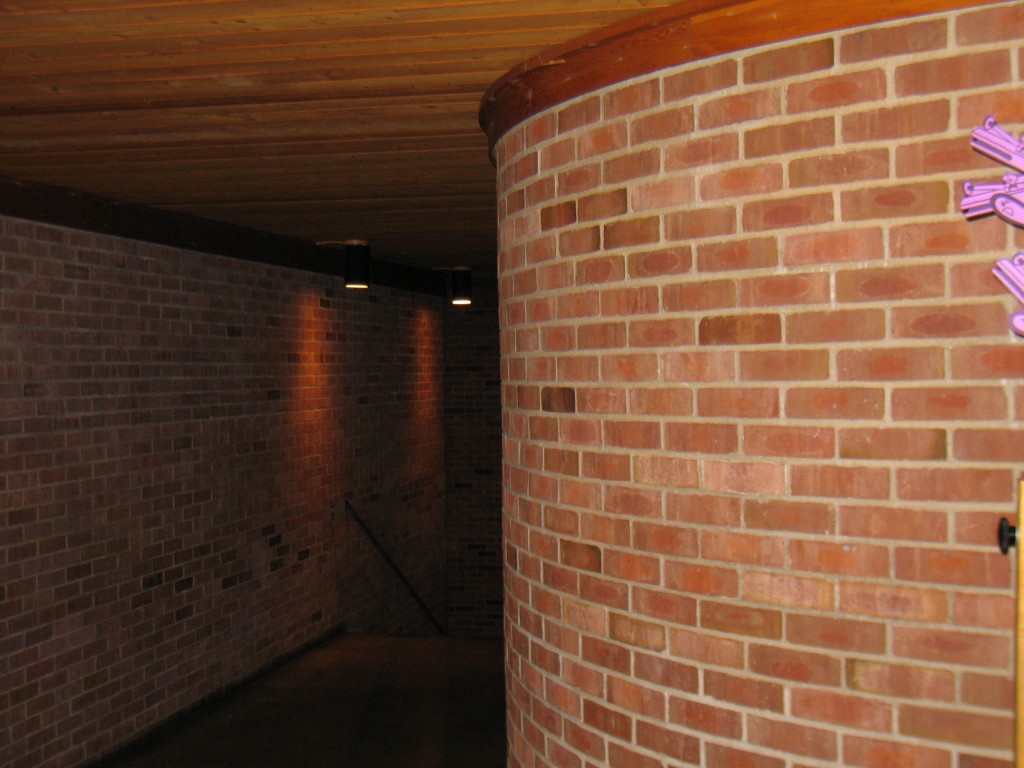 Interior hallway (photo by Ricky Berkey)
Interior hallway (photo by Ricky Berkey)
 Sanctuary (photo by Ricky Berkey)
Sanctuary (photo by Ricky Berkey)
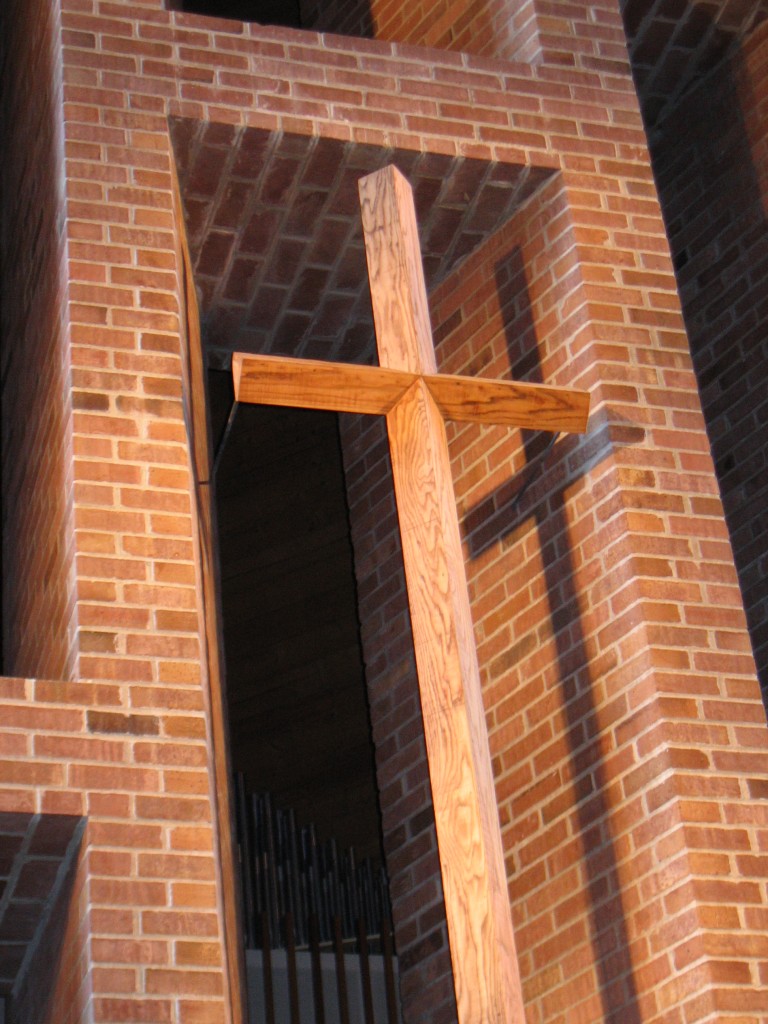 Sanctuary Cross (photo by Ricky Berkey)
Sanctuary Cross (photo by Ricky Berkey)
The Architect
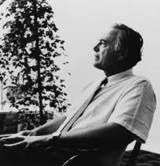 Harry Weese
Harry Weese
- Born June 30, 1915 in Evanston, Illinois
- Died October 29, 1998
- Yale University (1936-1937)
- Massachusetts Institute of Technology (MIT) (1934-1938)
- Cranbrook Academy (1939-1940)
Harry Weese was born in the Chicago suburbs and went on to become one of the most influential of the Chicago architects. His work predominated in Chicago, in little Columbus, Indiana and around the world. His many projects ranging from high-rises and giant urban complexes to intimate residential designs remain as a testament to his genius.
Harry was a student of renowned Finnish architect Alvar Aalto at MIT. He also studied city planning at the Cranbrook Academy in Bloomfield Hills, Michigan where he met and became close friends of Charles Eames and Eero Saarinen. His life was greatly influenced by his brief time at Cranbrook and his later interior design work can be seen as a result. His association with Eero Saarinen led to many projects as Saarinen referred projects to Weese that he simply didn’t have time to take on. He also became a close friend of J. Irwin Miller which led to over a dozen small projects in Columbus, Indiana.
He was primarily considered a modernist but his work was always shaped by the needs and vision of his clients. As a result his designs were almost always unique without an identifying personal style. Weese’s approach to design was problem solving – each work intended to meet a specific need and to fulfill a particular function.
Early on he worked for Skidmore, Owings and Merrill (SOM) but felt stifled in the world of corporate architecture and started his own much smaller firm in 1947. He also became a fierce advocate of historic preservation and city planning. He had a lifelong interest in sailing and boat-building which was often reflected in his designs especially in some of his residential projects. Harry Weese & Associates won the coveted Firm of the Year Award in 1978. In 45 years they completed over 300 commissions with perhaps an equal number of unbuilt designs.
His luster was tarnished in later years as his drinking and personal problems put a sad footnote on what should have been a celebrated life. After numerous stints in rehab clinics and several strokes his wife Kitty and family had him committed to the Illinois Veterans Home where he died quietly in 1998. Recently his work has come back into focus as a number of articles and a new book has been released on his life and works. Much like the recent surge of interest in Eero Saarinen, the work of Harry Weese is finally getting the critical respect and admiration that it always deserved.
Selected Harry Weese Projects
1957: Lillian C. Schmitt Elementary School – Columbus, Indiana
1958: United States Embassy Building – Accra, Ghana
1961: Northside Middle School – Columbus, Indiana
1963: Sterling Morton Library at the Morton Arboretum
1965: First Baptist Church – Columbus, Indiana
1966: Orchestra Hall Restoration – Chicago, Illinois
1966: IBM Building – Milwaukee, Wisconsin
1966: Tangeman House – Muskoka Lakes, Ontario, Canada
1967: Auditorium Theatre Restoration – Chicago, Illinois
1968: Seventeenth Church of Christ, Scientist – Chicago, Illinois
1969: Marcus Center for the Performing Arts – Milwaukee, Wisconsin
1969: Shadowcliff House – Ellison Bay, Wisconsin
1970: Time-Life Building: Chicago, Illinois
1970: Formica Building – Cincinnati, Ohio
1972: Arena Stage – Washington, D.C.
1973: Crown Center Hotel – Kansas City, Missouri
1975: Mercantile Bank – Kansas City, Missouri
1975: Oak Park Village Hall – Oak Park, Illinois
1975: Metropolitan Correctional Center – Chicago, Illinois
1976: Willow Street Townhouses – Chicago, Illinois
1976: Metro System – Washington D.C.
1981: Fulton House Condominium Conversion – Chicago, Illinois
1982: United States Embassy Housing – Tokyo, Japan
1984: Miami-Dade County Transit System – Dade County, Florida
1988: River Cottages – Chicago, Illinois
1988: Union Station Restoration – Washington, DC
Historic Columbus
This is the original First Baptist Church on Franklin Street which served the congregation from 1854 till 1965.
Links/References
“Reconstructing Harry Weese”: fascinating recent article about his life and career
“Harry Weese: A Man of Many Words and Works (1915-1998)” – a career retrospective from Inland Architect magazine.
The Architecture of Harry Weese: Robert Bruegmann and Kathleen Murphy Skolnik (recently published career retrospective)
Harry Weese Houses: Kitty Baldwin Weese (This book was written by Harry’s wife as a tribute for his 70th birthday – it illustrates 38 of his 82 residential designs).
Harry Weese Interview: part of the Chicago Architects Oral History Project
City of Columbus: official City of Columbus website
Columbus Indiana Architectural Archives
Columbus Indiana Architecture Digital Archives: A small portion of the Columbus Indiana Architectural Archives available online from the IUPUI digital library
3D Models of Columbus Architecture Executed in Google SketchUp:
The Republic Newspaper – Columbus, Indiana newspaper
Bartholomew County Public Library
Historic Columbus Website – David Sechrest’s tribute to Columbus History
Historic Columbus Message Board – a companion interactive forum to the David Sechrest historical website
Bartholomew County Historical Society
 Click HERE for a Calendar of Upcoming Events in the Columbus Area.
Click HERE for a Calendar of Upcoming Events in the Columbus Area.
Click HERE for information about Tours of Columbus Architecture and Design including the Miller House.
 Ricky Berkey
Ricky Berkey
Email me: rickyberkey@gmail.com

